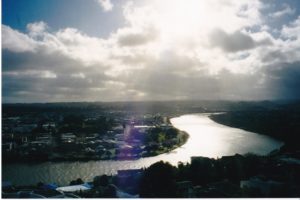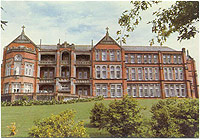A brief history of the Whanganui Congregation of the Sisters of Saint Joseph

Whanganui, Aotearoa New Zealand, is defined by its mighty Awa (river) which flows from the Central Mountains to the Tasman Sea. Along its length, Te Atihaunui-a-Paparangi (Whanganui people) have lived for 40 generations, and the river is an integral part of their lives.
The first Europeans arrived from England, Scotland and Ireland in the 1840s. Land purchases were negotiated with Whanganui Māori, and finalised in 1848. A military garrison was positioned in the town from 1846 until 1870 due to disturbances from the New Zealand Land Wars.
French Marist missionaries founded mission stations up and down the Awa, and also ministered to the newly arrived. The first Catholic church was built in 1857; the first Catholic school opened in 1866.
When Sisters Hyacinth Quinlan, Clare Rubie, Joseph Kinsella, and Teresa Schmidt arrived at the river wharf in the early hours of 24 April 1880, they were welcomed by the parish priest, Rev Dean Kirk, who with Bishop Redwood had invited them. They came from Perthville NSW, four years after the Diocesan Congregation had been formed. Their knowledge of the country and the Māori people was minimal. They were young, had come from a time of upheaval and estrangement in the Congregation, and were facing great expectations. Boarders for the school were ready and three women to join their community.

In 1883, the Sisters were asked by Bishop Redwood to help start a school at Hiruhārama (Jerusalem) where the original Marist mission had lapsed during the troubled times on the river. Sr Teresa Schmidt and Sr Aloysius Malone were to accompany a French woman, Suzanne Aubert, a nurse fluent in Te Reo (Māori language). The women travelled upriver in waka (canoes), staying in Māori settlements. They returned to Whanganui two years later. Suzanne Aubert went on to begin the first NZ Congregation – the Daughters of Our Lady of Compassion.
In 1885 a foundation was made in Hāwera, Taranaki, and in the following 25 years, seven convents and schools were begun. Land was sought for the growing Congregation and in 1912 Sacred Heart, a large three-story building, was opened on St John’s Hill in Whanganui. A Chapel which still stands was opened in 1918. Further foundations were made, mainly in the central and lower North Island.
The Sisters formalised their connections with the four Diocesan Congregations in Australia, with the Federation of the Australia-New Zealand Sisters of St Joseph in 1967. By the new millennia, each Congregation was going through its own processes of discernment. For the Whanganui Sisters there was much soul-searching until the decision in 2012 to request Fusion with the Sisters of Saint Joseph of the Sacred Heart. Fusion was granted in February 2013 and celebrated in Whanganui on 24 August 2013.
The journey of the Whanganui Sisters of Saint Joseph has had its ebbs and flows. Numbers have fallen, ministries changed, buildings demolished. But just as the mighty Whanganui Awa flows onward, so also the charism continues to flow through all those who live the spirit of Saint Joseph.
Anne Burke rsj
